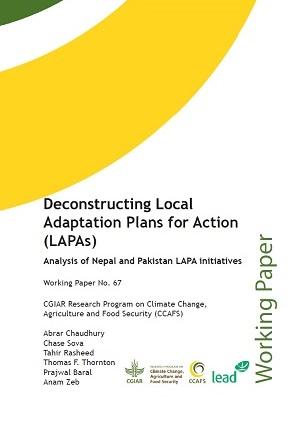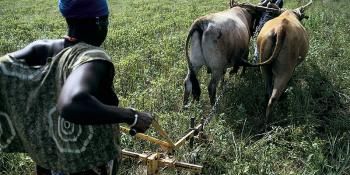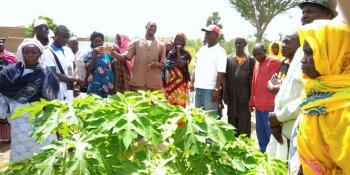Bite-size planning: can local adaptation planning motivate south-south learning exchanges?

Local planning offers farmers a viable opportunity to adapt to uncertain climate change. A new working paper explores two ongoing Local Adaptation Plan of Action (LAPA) initiatives in Pakistan and Nepal, to highlight the potential of South-South learning
 Unpredictable rains are a farmer’s biggest nightmare. Too much of it or too little of it can have devastating impacts on the crops and livelihoods of farmers. The floods of 2010 summer in Pakistan are testament of the havoc heavy monsoons coupled with glacial melt due to rising temperatures can bring to a country.
Unpredictable rains are a farmer’s biggest nightmare. Too much of it or too little of it can have devastating impacts on the crops and livelihoods of farmers. The floods of 2010 summer in Pakistan are testament of the havoc heavy monsoons coupled with glacial melt due to rising temperatures can bring to a country.
More than one fifth of the country was under water resulting in billions of dollars in damage and displacements of millions of vulnerable citizens. The floods were followed by periods of droughts in unpredictable cycles making agriculture, especially for smallholding farmers, an extremely high-risk activity. This raises a pertinent and ever-present question, “how do smallholding farmers plan for this unpredictability and risk?”
This is the precise question that is being explored by developers of two ongoing Local Adaptation Plan of Action (LAPA) initiatives in Pakistan and Nepal. LAPA, as its name suggests, is a local planning process to address the impacts of the most pressing climate change challenges relevant to local communities. It translates broad national adaptation policies, into meaningful action and monitoring plans at village and community-levels by capturing local needs and directing resources to where, when and by whom these are most needed.
Impacted, local communities are in charge of the design process of the LAPAs with support from local partners and governments by applying innovative participatory tools and local consultations. Ultimately LAPAs aim to empower local people to undertake their own analysis, take command, gain confidence, and to make their own decisions.
A new CCAFS working paper by researchers from CCAFS, University of Oxford and LEAD Pakistan deconstruct two LAPA initiatives in Nepal and Pakistan to understand the organizational design and implementation strategies behind the LAPAs. The aim is to explore what factors make certain organizational designs appropriate in certain circumstances and inappropriate in others.
While both Nepal and Pakistan LAPAs share similar underlying goals of bottom-up local-level planning for adaptation, the organizational designs of the two LAPAs are very distinct. The resulting outcomes from the LAPAs in the two countries hence may be very different. The Nepal LAPA takes a more formal approach of creating a national framework ratified by the parliament followed by downstream implementation. Pakistan LAPA on the other hand follows a project approach of implementation first through local partners to scale up the process as a national framework.
Despite different structural forms, the Nepal and Pakistan LAPAs share many common challenges. While the Nepal LAPA is a national framework and the Pakistan LAPA is a donor-funded project, continuity of both LAPAs are financially dependent on the availability of future donor funding.
The Pakistan LAPA development process is at an early stage with 6 LAPAs completed, compared with 70 LAPAs completed in Nepal, with additional 30 LAPAs advanced for implementation. Despite the different maturity of the LAPAs, adaptation in agriculture and food security has emerged as the top ranked thematic priority in both countries (43% in Nepal and 68% in Pakistan of total identified priorities), emphasizing the sensitivity and importance of the agriculture sector to local communities.
This paper comes at an important stage when both LAPA processes are still at an incipient stage. Many developing countries are taking similar approaches or expected to replicate the existing LAPA frameworks in some form or the other for local-level adaptation planning and implementation. Early lessons from the design process of the LAPA and on-ground implementation are invaluable not only to highlight successful features but also to flag potential areas of concern for future LAPA development initiatives by other countries.
The working paper will ultimately serve to motivate south-south learning exchanges between implementing countries. Besides, as local planning is also a key focus of the CGIAR program on Climate Change, Agriculture and Food Security (CCAFS), the working paper will be relevant, especially from 2015, when local adaptation planning will become a core objective of the CCAFS programme – in a drive towards creating an enabling environment for Climate Smart Agriculture adoption and scaling up of practices.
It is worth saying that, while LAPAs may be the right step towards local adaptation, they cannot help farmers predict the exact date when the rains will come. Even the best scientific climate models often fall short of making good estimates. Where LAPA can play a critical role is to harness the cumulative power of local knowledge. Designing localized solutions by the community for the community offers farmers the best chance to succeed in times of uncertainty, especially when there is too much or too little water.
Download the paper: Abrar Chaudhury, Chase Sova, Tahir Rasheed, Thomas F. Thornton, Prajwal Baral, Anam Zeb. 2014. Deconstructing Local Adaptation Plans for Action (LAPAs) - Analysis of Nepal and Pakistan LAPA initiatives. CCAFS Working Paper No. 67



